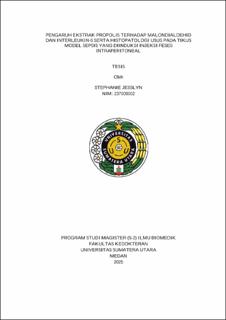Pengaruh Ekstrak Propolis Terhadap Malondialdehid dan Interleukin-6 serta Histopatologi Usus pada Tikus Model Sepsis yang Diinduksi Injeksi Feses Intraperitoneal
The Effect of Propolis Extract on Malondialdehyde and Interleukin-6 and Intestinal Histopathology in A Rat Model of Sepsis Induced by Intraperitoneal Fecal Injection

Date
2025Author
Jesslyn, Stephanie
Advisor(s)
Malisie, Ririe Fachrina
Widjaja, Sry Suryani
Metadata
Show full item recordAbstract
Background: Dysbiosis contributes to the development of inflammatory diseases through the destruction of intestinal barrier or leaky gut, allowing pathogens to invade the intestines and triggering the release of proinflammatory factors. Dysbiosis and leaky gut are interconnected in sepsis, as sepsis can cause dysbiosis and dysbiosis can worsen sepsis. The Surviving Sepsis Campaign (SSC) 2021 recommends broad-spectrum empiric therapy with one or more antimicrobials for sepsis patients, but with the ever-changing distribution of causative pathogens and the emergence of pathogen resistance, broad-spectrum antimicrobial therapy is becoming less effective. Prolonged antibiotic treatment can cause dysbiosis. Therefore, an adjunctive therapy such as gut microbiota modulation is needed to reduce the severity of sepsis. Propolis or bee glue has positive effects on gut microbiota, which plays a role in regulating oxidative stress and inflammation as well as maintaining gut integrity.
Objective: To analyze the effects of propolis extract on malondialdehyde (MDA) and interleukin (IL)-6 as well as the histopathological features of terminal ileum and proximal colon in septic rat model induced by intraperitoneal fecal injection.
Methods: Thirty-five male Wistar rats were divided into five groups: K1, healthy rat group; K2, septic rat group + intraperitoneal antibiotics; K3, septic rat group + intraperitoneal antibiotics + 150 mg/kgBW/day per oral propolis extract; K4, septic rat group + intraperitoneal antibiotics + 200 mg/kgBW/day per oral propolis extract; K5, septic rat group + intraperitoneal antibiotics + 250 mg/kgBW/day per oral propolis extract. Measurement of MDA and IL-6 levels was performed using Enzyme-linked Immunosorbent Assay (ELISA) on the rat serum. Histopathological features of the terminal ileum and proximal colon of rats were assessed using the Chiu score and the Appleyard and Wallace score. One-way Anova, Kruskal-Wallis, and post-hoc LSD and Mann-Whitney tests were used to analyze the comparison of biomarker means and histopathological scores.
Results: This study found that propolis extract administration decreased the mean serum MDA levels of septic rat model, but the decrease was not significant (p = 0.906). Propolis extract administration also increased the mean serum IL-6 levels of septic rat model, but the increase was not significant (p = 0.335). This study found that propolis extract administration significantly improved the microscopic appearance of terminal ileum and proximal colon of septic rat model, which was shown by a significant decrease in the mean Chiu score and Appleyard and Wallace score (p = 0.015; p = 0.022). Propolis extract administration at a dose of 200 mg/kgBW/day significantly decreased the average Chiu score (p = 0.016) and Appleyard and Wallace score (p = 0.003).
Conclusion: In the septic rat group given propolis at a dose of 150 mg/kgBW/day and 200 mg/kgBW/day, there was a decrease in the mean serum MDA levels compared to the septic rat group without propolis administration, but the decrease was not significant, while in the septic rat group given propolis at a dose of 250 mg/kgBW/day, there was an increase in the mean serum MDA levels compared to the septic rat group without propolis administration, but the increase was not significant. In the septic rat group given propolis at a dose of 150 mg/kgBW/day, 200 mg/kgBW/day, and 250 mg/kgBW/day, there was an increase in the mean serum IL-6 levels compared to the septic rat group without propolis administration, but the increase was not significant. Administration of propolis extract at a dose of 200 mg/kgBW/day caused significant improvements in the histopathological features of the terminal ileum and proximal colon of septic rat model.
